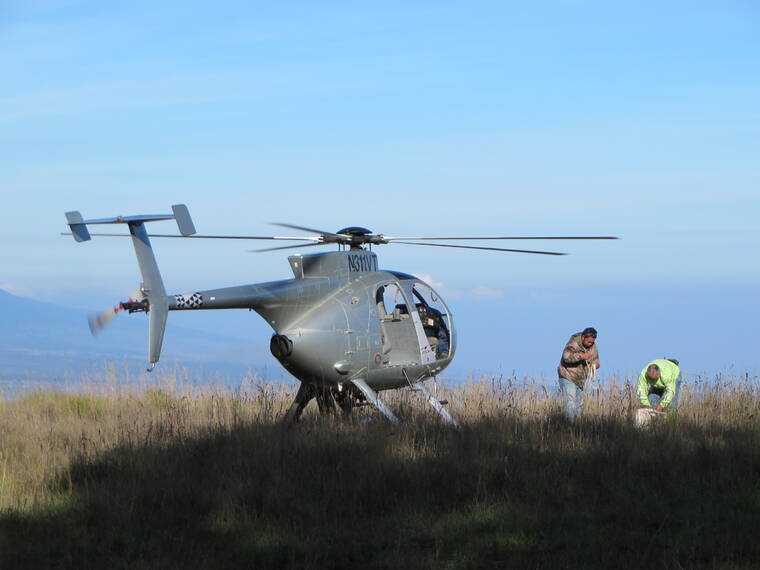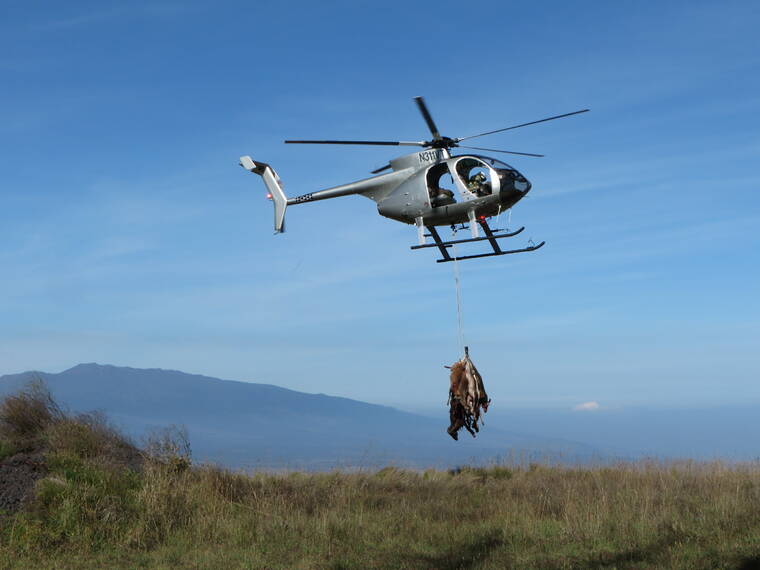The state Department of Land and Natural Resources will conduct aerial hunting operations to reduce sheep populations in Maunakea forest reserves at the end of the month.
Between 8 p.m. Jan. 30 and 7 p.m. Feb. 1, the Maunakea Forest Reserve, Maunakea Ice Age Natural Area Reserve, Palila Mitigation Lands and Kaohe Game Management Area will be closed to most members of the public while DLNR staff hunt sheep and goats from helicopters.
“We’ll be actively eradicating sheep and goats from palila habitats,” said Kanalu Sproat, wildlife biologist for the DLNR’s Division of Forestry and Wildlife.
Palila, or the Hawaiian honeycreeper, is a critically endangered native bird that is only found in the wild on Maunakea’s southwestern slopes.
An October DLNR report estimated that there are fewer than 300 of the species alive in the wild.
Because the palila population is concentrated in such a small habitat, any disruption there can have extreme consequences to the species. In particular, feral ungulates such as sheep and goats graze on Maunakea, which reduces the density of vegetation that shelter and feed palila.
Sproat said the DLNR expects to kill between 40 and 80 ungulates during the hunting operation, which will be the first of a quarterly series of hunts this year.
“It used to be we would do these monthly, and we would get around 80 to 100 over two days,” Sproat said. “We’ve gone from getting 100 sheep every month, to getting between 40 and 80 every quarter, so that’s a good sign.”
While the eradication of ungulates has improved the vegetation density in the palila’s habitat, it has had the side effect of increasing the risk of wildfire — an even greater threat to the bird — by increasing the amount of flammable brush across Maunakea. The DLNR will address this threat throughout the next two years by expanding firebreaks in the Maunakea Forest Reserve.
While DOFAW will make efforts to salvage the animal carcasses after the hunting operation, Sproat estimated that only about 50% of them will be recovered.
Members of the public who are granted a salvage permit will be allowed to retrieve the animal carcasses from two sites during the operation: On Jan. 31, those with permits who arrive at the Kilohana check-in station at 7 a.m. can retrieve the animals at Puu Ahumoa, while on Feb. 1, those with permits must meet across from the Waimea Veterinary Associates office on Mana Road in Waimea at 6 a.m. to collect carcasses at Puu Mali.
Four-wheel-drive vehicles are required to access both sites. The DLNR also does not guarantee that any animals will be available for salvage.
To receive a permit, applicants need to call the DOFAW office in Waimea at (808) 887-6063 between Jan. 24 and Jan. 30, submit their name, license plate number and vehicle make and model, and the names of any passengers.
Even with a permit, only the first 15 permitted vehicles at either location will be allowed to proceed.
Email Michael Brestovansky at mbrestovansky@hawaiitribune-herald.com.









